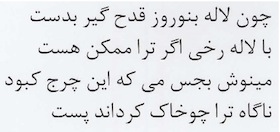Robes and Fabrics - Pardeh-qalamkâr (Wall hanging)
Illustrating a loving couple
Size: h. 135.5 cm, w. 90 cm
Origin and time: Iran, Isfahan, about 1900
Museum of Ethnology, Vienna
Inv. No. VO_180296 (Collection: Fritz Willfort)
The highly popular printed fabrics from Isfahan are typical of the time of the Qajar dynasty (1794 to 1925). Although the Farsi word qalamkâr literally means “drawing with a pen”, in most cases the patterns were not painted on the fabric but rather imprinted by means of wooden moulds or stamps. The qalamkârs were produced by combining textile printing and pre-mordanting. Selected parts of the fabric were treated with mordants (e.g. alum), so as to fix dyes only onto these parts but not the rest of the fabric. Thus, the parts of the fabric not treated with mordants remain reserves.
The borders of painted qalamkârs are decorated with block patterns, while the centre of the fabric is hand-painted. First of all, the painter draws the image on a sheet of paper, then he perforates the contours and finally he copies the sheet onto the fabric by sprinkling pulverised coal over the perforated contours. Usually the qalamkârs show images of heroic stories, fighting, hunting and love scenes. Depending on the motif, the qalamkârs were used for making clothes, hangings, quilts and similar textiles. This particular qalamkâr shows a couple sitting under a tree and drinking wine. The inscription is a four-line verse of the Persian mystic Omar-e Khayyâm (1048 to 1131) recalling Horace´s “Carpe diem” (Carmen I, XI) Latin poem.

Chûn lâleh be norûzt ghadah gîr bedast
Bâ lâleh rukhî agar torâ monken (h)ast
Meynûsh bejus mey keh in charkh kabûd
Nâgâh torâ kardand past.
Raise your goblet, the shape of a tulip
And merrily drink wine for Naruz
When luck is with you in the company of a tulip-cheeked maiden
Since the day will come when under the blue sky you will crumble into dust
